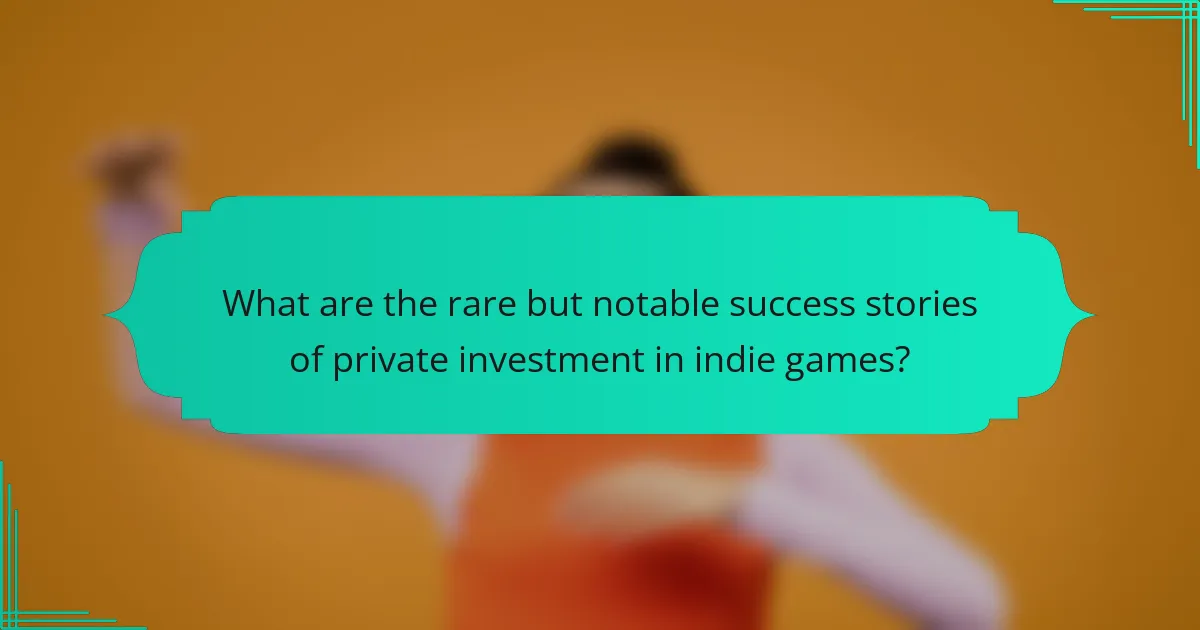Private investors in indie games seek financial returns, creative engagement, and unique market opportunities. They identify promising projects through market analysis and networking, while expecting innovative gameplay and effective marketing strategies. Challenges such as limited market insight and project volatility require strong collaboration with developers. Successful investment stories like “Undertale” and “Stardew Valley” demonstrate the transformative impact of strategic funding in the indie game sector.

What are the key motivations for private investors in indie games?
Private investors in indie games are primarily motivated by potential financial returns, creative engagement, and market trends. Financial returns attract investors seeking high growth opportunities in a rapidly evolving gaming landscape. Creative engagement allows investors to support innovative projects, often collaborating with passionate developers. Market trends, including the rise of digital distribution and the popularity of indie titles, further drive interest, as investors recognize the increasing demand for unique gaming experiences.
How do financial returns influence investment decisions?
Financial returns significantly impact investment decisions for private investors in indie games. Investors prioritize potential profitability and market trends when evaluating projects. High return expectations drive funding choices, influencing which games receive financial backing. Additionally, networking among investors can enhance opportunities for profitable investments through shared insights and connections.
What role does personal passion for gaming play?
Personal passion for gaming significantly enhances private investors’ engagement and decision-making in indie games. This enthusiasm drives investors to seek innovative projects, fostering a supportive environment for developers. Passionate investors often provide not just funding but also valuable insights and networking opportunities, which can lead to greater success for indie games. Their unique understanding of the gaming landscape allows them to identify promising trends and align investments with their interests, ultimately benefiting both parties.
Which market trends attract private investors?
Market trends attracting private investors in indie games include innovative gameplay mechanics, strong community engagement, and diverse monetization strategies. The rise of digital distribution platforms enhances accessibility and visibility for indie titles. Additionally, data-driven insights into consumer preferences guide investment decisions. Unique attributes like cross-platform compatibility and immersive storytelling also appeal to investors, as they increase market potential. As a result, private investors are increasingly drawn to projects that showcase originality and scalability.

What strategies do private investors use to identify promising indie games?
Private investors identify promising indie games through market analysis, networking, and financial viability assessments. They evaluate gameplay mechanics, storytelling, and unique selling points to gauge potential success. Investors often attend industry events to connect with developers and discover innovative projects. They also analyze trends in player preferences and revenue models to make informed decisions.
How do investors assess the viability of a game concept?
Investors assess the viability of a game concept through market analysis, gameplay mechanics, and financial projections. They examine target audience demand, competition, and unique selling points. A well-defined prototype can enhance investor confidence. Strong networking can also influence investor decisions, as relationships often lead to funding opportunities.
Which metrics are critical for evaluating potential success?
Key metrics for evaluating potential success in indie game investments include player engagement, funding efficiency, market reach, and return on investment.
Player engagement measures user retention and satisfaction, often assessed through metrics like daily active users and session length. Funding efficiency evaluates how effectively capital is utilized, typically analyzed through budget adherence and cost per acquisition. Market reach looks at the game’s visibility and audience size, often indicated by download numbers and social media engagement. Return on investment quantifies financial success, usually expressed as a percentage based on profits relative to initial funding.
What tools or platforms assist in the discovery of indie games?
Platforms like Kickstarter, Fig, and IndieGoGo enable indie game discovery through funding and community engagement. Networking events and online forums also connect investors with developers. These tools help showcase potential projects and facilitate strategic partnerships.

What are the common expectations of private investors in the indie game sector?
Private investors in the indie game sector typically expect strong returns, innovative gameplay, and effective marketing strategies. They prioritize clear communication and transparency throughout the investment process. Investors also look for a passionate team and a well-defined target audience. Additionally, they value unique game concepts that differentiate from mainstream offerings.
How do investors envision their involvement in the game’s development?
Investors envision their involvement in game development as a collaborative partnership. They seek to influence creative direction while ensuring financial returns. Investors expect transparency, regular updates, and alignment with their strategic goals. This engagement fosters a supportive environment, enhancing the game’s potential for success.
What are the anticipated timelines for returns on investment?
Returns on investment for private investors in indie games typically range from 2 to 5 years. Factors influencing this timeline include game development duration, market trends, and promotional strategies. Successful indie games may yield substantial returns within this period, while others may take longer due to market saturation or limited audience reach. Networking and strategic planning can significantly enhance the likelihood of timely returns.
How do investors measure success beyond financial returns?
Investors measure success beyond financial returns by evaluating the impact of indie games on community engagement, player satisfaction, and cultural significance. These factors reflect a game’s ability to resonate with an audience and foster a loyal fan base. Additionally, networking opportunities within the indie game community can enhance an investor’s reputation and influence, contributing to long-term success. Collaboration with developers and participation in gaming events can lead to valuable insights and relationships that extend beyond mere profit metrics.

What networking opportunities exist for private investors in the indie game industry?
Private investors in the indie game industry can access various networking opportunities through events, online platforms, and industry associations. Participating in gaming conventions allows investors to meet developers and other investors. Online forums and social media groups foster connections and discussions. Additionally, joining industry associations can provide exclusive networking events and resources. These opportunities enhance collaboration and investment prospects in the growing indie game market.
Which industry events are critical for connecting with indie developers?
Key industry events for connecting with indie developers include PAX, GDC, IndieCade, and the Game Developers Conference. These gatherings provide networking opportunities and access to private investors interested in indie games. Attending these events can lead to valuable partnerships and funding opportunities.
How can social media platforms facilitate investor-developer connections?
Social media platforms can enhance connections between private investors and indie game developers through networking opportunities and targeted outreach. Platforms like LinkedIn and Twitter allow developers to showcase projects, share updates, and engage with potential investors. These interactions can lead to collaborations, funding discussions, and community building. Furthermore, specialized groups and forums on these platforms facilitate focused conversations, enabling investors to discover promising projects that align with their interests.
What role do online communities play in building investor networks?
Online communities significantly enhance investor networks for indie games by fostering connections and facilitating collaboration. These platforms allow private investors to share insights, discuss trends, and discover emerging projects. Engaging in these communities helps investors identify unique opportunities, assess expectations, and strategize effectively. Moreover, they offer a rare chance to interact directly with game developers, creating a valuable exchange of ideas and resources. As a result, online communities play a crucial role in building robust networks for private investors in the indie game sector.

What unique challenges do private investors face when funding indie games?
Private investors in indie games face unique challenges such as limited market insight, high risk of project failure, and difficulty in establishing trust with developers. These factors can hinder investment decisions and affect potential returns. Additionally, the indie game market is often volatile, making it challenging to predict trends and profitability. Networking with developers and understanding their creative visions are essential for overcoming these obstacles.
How do market saturation and competition impact investment decisions?
Market saturation and competition significantly influence investment decisions in indie games. High saturation can deter investment due to perceived risks and lower returns. Conversely, unique game concepts in less saturated markets attract private investors seeking innovative opportunities. Investors often analyze competition levels to gauge potential success and market viability. Understanding these dynamics helps investors align their strategies with market conditions and optimize their funding outcomes.
What are the risks associated with investing in unproven game developers?
Investing in unproven game developers carries significant risks, including financial loss, lack of market viability, and project delays. Many indie games fail to secure funding or attract players, leading to unsustainable business models. Additionally, inexperienced developers may lack the necessary skills to deliver quality products on time. Market saturation further complicates success, as numerous titles compete for limited attention. Without established track records, investors face uncertainty regarding returns on investment.
How do cultural differences influence investment strategies across regions?
Cultural differences significantly shape investment strategies in indie games across regions. Investors often prioritize local market trends, consumer preferences, and cultural narratives.
In North America, private investors focus on innovative gameplay and storytelling, driven by a culture that values creativity and risk-taking. In contrast, European investors may emphasize artistic expression and social themes, reflecting diverse cultural backgrounds.
Asian markets often highlight mobile gaming, influenced by high smartphone penetration and rapid technological adoption. This cultural inclination towards mobile platforms leads to distinct investment strategies that prioritize user engagement and monetization models.
Understanding these cultural nuances allows private investors to tailor their strategies effectively, ensuring alignment with regional expectations and maximizing potential returns.

What are the rare but notable success stories of private investment in indie games?
Notable success stories of private investment in indie games include titles like “Undertale,” “Stardew Valley,” and “Hollow Knight.” These games exemplify how strategic funding can enhance creativity and market reach. Private investors often provide not just capital but also valuable industry connections. For instance, “Stardew Valley” saw significant growth due to community engagement and investor support, leading to over 10 million copies sold. Similarly, “Hollow Knight” gained critical acclaim and commercial success, showcasing the potential of indie games with the right backing. These examples highlight the impact of private investment in transforming indie projects into successful franchises.
Which indie games achieved unexpected success through private funding?
Several indie games have achieved unexpected success through private funding, leveraging strategic investor relationships. Notable examples include “Hollow Knight,” which received substantial backing from private investors, allowing for a polished final product. “Celeste” also garnered attention and funding, leading to its critical acclaim and commercial success. “Stardew Valley” stands out as another success story, where initial personal investment paved the way for its widespread popularity. Each of these games exemplifies how private funding can transform indie projects into breakout hits.
How did investor involvement shape the trajectory of these games?
Investor involvement significantly influenced the development and success of indie games through strategic funding and networking. Private investors provided essential capital that allowed developers to focus on creativity and innovation. This financial backing often came with expectations for market viability and profitability, shaping game design and marketing strategies. Additionally, investors facilitated networking opportunities, connecting developers with industry veterans, which enhanced visibility and market reach. These dynamics created a supportive ecosystem that propelled indie games into the mainstream, driving both creative and commercial success.
What lessons can be learned from these success stories?
Private investors in indie games can learn valuable lessons from success stories by focusing on strategic partnerships, clear communication, and realistic expectations. Networking with industry professionals enhances opportunities for collaboration and insight. Successful projects often emphasize a unique vision, aligning investor interests with creative goals. Additionally, understanding market trends and player preferences can significantly improve investment outcomes.
What are the best practices for private investors in the indie game landscape?
Private investors in the indie game landscape should focus on strategic funding, clear expectations, and effective networking. Establishing relationships with developers is crucial for understanding project viability. Investors should conduct thorough market research to identify trends and successful genres. Setting realistic financial goals and timelines helps manage expectations. Participating in industry events fosters connections and provides insights into emerging opportunities.
How can investors effectively communicate with developers?
Investors can effectively communicate with developers by establishing clear expectations and maintaining open dialogue. Regular updates and feedback sessions foster trust and transparency. Building relationships through networking events enhances understanding of each other’s goals. Clear documentation of agreements and progress ensures alignment throughout the project.
What common pitfalls should investors avoid when entering the indie game market?
Investors should avoid rushing into investments, neglecting due diligence, and underestimating market trends. Failing to establish clear communication with developers can lead to misunderstandings. Additionally, overlooking the importance of networking within the indie game community can hinder success. Lastly, unrealistic expectations regarding returns can lead to disappointment.
